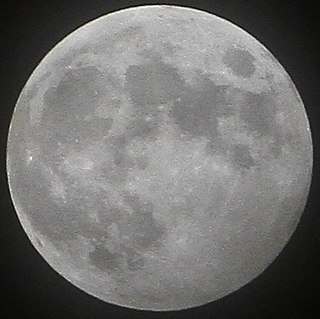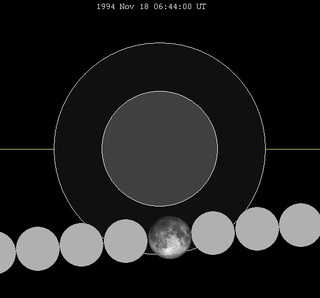
A penumbral lunar eclipse took place on Tuesday, May 25, 1937, the first of two lunar eclipses in 1937.

A penumbral lunar eclipse took place on Tuesday, May 25, 1937, the first of two lunar eclipses in 1937.
| Ascending node | Descending node | |||||
|---|---|---|---|---|---|---|
| Saros | Date Viewing | Type Chart | Saros | Date Viewing | Type Chart | |
| 110 | 1937 May 25  | Penumbral | 115 | 1937 Nov 18  | Partial | |
| 120 | 1938 May 14  | Total | 125 | 1938 Nov 07  | Total | |
| 130 | 1939 May 03  | Total | 135 | 1939 Oct 28  | Partial | |
| 140 | 1940 Apr 22  | Penumbral | 145 | 1940 Oct 16  | Penumbral | |
A lunar eclipse will be preceded and followed by solar eclipses by 9 years and 5.5 days (a half saros). [1] This lunar eclipse is related to one total and one partial = two solar eclipses of Solar Saros 117.
| May 19, 1928 | May 30, 1946 |
|---|---|
 |  |

A total lunar eclipse took place on Sunday, November 9, 2003, the second of two total lunar eclipses in 2003, the first being on May 16, 2003. It is the first total lunar eclipse of 21st century which happened on a micromoon day. The Moon barely edged into total eclipse for 21 minutes and 58 seconds. With the Moon just 1.78% of its diameter into the Earth's umbral shadow, the Moon may have been quite bright, but even so, this should have been worth seeing. The partial eclipse lasted for 3 hours, 31 minutes and 25 seconds. Occurring only 1.4 days before apogee, the Moon's apparent diameter was 6.4% smaller than average.

A total lunar eclipse took place on Friday, February 9, 1990, the first of two lunar eclipses in 1990.

A penumbral lunar eclipse took place on April 24, 2005, the first of two lunar eclipses in 2005. At maximum eclipse, 86.5% of the Moon's disc was partially shaded by the Earth, which caused a slight shadow gradient across its disc; this subtle effect may have been visible to careful observers. No part of the Moon was in complete shadow. The eclipse lasted 4 hours and 6 minutes overall, and was visible from east Asia, Australia, and the Americas.

A total lunar eclipse took place on Sunday 16 July 2000, the second of two total lunar eclipses in 2000.

A total lunar eclipse took place on Friday 21 January 2000, the first of two total lunar eclipses in 2000.

A partial lunar eclipse took place on 25 April 2013, the first of three lunar eclipses in 2013. Only a tiny sliver (1.48%) of the Moon was covered by the Earth's umbral shadow at maximum eclipse, but the entire northern half of the Moon was darkened from being inside the penumbral shadow. This was one of the shortest partial eclipses of the Moon for the 21st century, lasting 27 minutes. This was the last of 58 umbral lunar eclipses of Lunar Saros 112.

A penumbral lunar eclipse took place on 18–19 October 2013, the last of three lunar eclipses in 2013.

A total lunar eclipse will take place between Monday and Tuesday, June 25-26, 2029. A central total eclipse lasting 1 hour and 41 minutes 53 seconds will plunge the full Moon into deep darkness, as it passes right through the centre of the Earth's umbral shadow. While the visual effect of a total eclipse is variable, the Moon may be stained a deep orange or red color at maximum eclipse. It will be able to be seen from most of the Americas, Western Europe and Africa. The partial eclipse will last for 3 hours and 39 minutes 32 seconds in total.
A total lunar eclipse took place on Tuesday, July 6, 1982, the second of three total lunar eclipses in 1982, and the only one that was in the descending node. A dramatic total eclipse lasting 1 hour and 46 minutes plunged the full Moon into deep darkness, as it passed right through the centre of the Earth's umbral shadow. While the visual effect of a total eclipse is variable, the Moon may have been stained a deep orange or red colour at maximum eclipse. This was a great spectacle for everyone who saw it. The partial eclipse lasted for 3 hours and 56 minutes in total.
A total lunar eclipse took place on Saturday, May 24 and Sunday, May 25, 1975, the first of two total lunar eclipses in 1975. The Moon was plunged into darkness for 1 hour and 28 minutes in a deep total eclipse which saw the Moon 43% of its diameter inside the Earth's umbral shadow. The visual effect of an eclipse depends on the state of the Earth's atmosphere, but the Moon may have been stained a deep red colour. The partial eclipse lasted for 3 hours and 35 minutes in total. Occurring only 4.4 days after perigee, the Moon's apparent diameter was 0.7% larger than average. The moon was 377,010 km from the Earth at greatest eclipse.

A total lunar eclipse took place on Thursday, June 25, 1964. The moon passed through the center of the Earth's shadow.
A total lunar eclipse took place on Thursday, April 24, 1986, the first of two total lunar eclipses in 1986, the second being on October 17, 1986. The Moon was plunged into darkness for 1 hour, 3 minutes and 34.8 seconds, in a deep total eclipse which saw the Moon 20.217% of its diameter inside the Earth's umbral shadow. The visual effect of this depends on the state of the Earth's atmosphere, but the Moon may have been stained a deep red colour. The partial eclipse lasted for 3 hours, 18 minutes and 46.8 seconds in total. The Moon was just 1.2 days before perigee, making it 5.3% larger than average.

A partial lunar eclipse took place on Wednesday, May 25, 1994, the first of two lunar eclipses in 1994, the second being with a penumbral lunar eclipse on Friday, November 18.

A penumbral lunar eclipse took place on Friday, November 18, 1994, the second of two lunar eclipses in 1994, the first was a partial lunar eclipse on Wednesday, May 25.
A penumbral lunar eclipse took place on Tuesday, May 15, 1984, the first of three lunar eclipses in 1984. This was a deep penumbral eclipse, with the southern limb of the Moon close to the Earth's shadow.
A penumbral lunar eclipse will take place on Monday, March 25, 2024. It will be visible to the naked eye as 95.57% of the Moon will be immersed in Earth's penumbral shadow.

A penumbral lunar eclipse will take place on May 7, 2031.
A partial lunar eclipse took place on Thursday, May 13, 1976, the first of two lunar eclipses in 1976, the second being a penumbral lunar eclipse on November 6, 1976. At maximum eclipse, a small bite out of the Moon should have been visible. The eclipse lasted for 1 hour, 15 minutes and 23.8 seconds, with just 12.17% of the Moon in shadow at maximum. Occurring only 1.1 days after perigee, the Moon's apparent diameter 5.4% larger than average.
A penumbral lunar eclipse took place on Saturday, November 6, 1976, the second of two lunar eclipses in 1976, the first being on May 13. This subtle penumbral eclipse may have been visible to a skilled observer at maximum eclipse. 83.827% of the Moon's disc was partially shaded by the Earth, which caused a gentle shadow gradient across its disc at maximum; the eclipse as a whole lasted 4 hours, 25 minutes and 52.1 seconds. Occurring only 0.3 days after apogee, the moon's apparent diameter was 6.5% smaller than average.

A total lunar eclipse took place on Sunday, July 26, 1953.